Fully updated and dripping with even more carbon-fibre, the second-generation Panigale SP is now even easier to ride like a pro on track. We grabbed some hot laps at the Misano MotoGP racetrack.
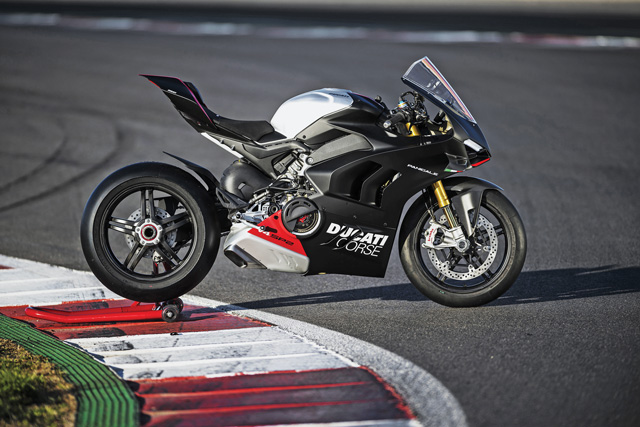
Story: Adam Child
Photography: Lorenzo Concari/Photohouse
Just 12 months after the launch of the Panigale V4 SP, Ducati have introduced an updated SP2 version of the Bologna factory’s exotic, track-focused superbike. Now the SP2 is brought into line with the 2022 Ducati Panigale with a 1.5-hp boost for a maximum of 215.5 hp at 13,000 revolutions per minute (rpm), with max torque of 123.6 Nm at 9,500 rpm and four riding modes: Street, Sport, Race A, and Race B. There is an STM-EVO dry slipper clutch that sounds fabulous and a lighter 520 chain along with an optional titanium Akrapovič system that takes the power up to 228 hp while trimming five kilograms from the SP2’s mass. Suspension, too, is aligned with that found on the new V4 S, meaning Öhlins Smart EC 2.0 electronic control system with Öhlins NPX25/30 forks replacing the NIX-30 units and a TTX36 shocker at the rear.
Primarily, though, the SP2 is a glorious exercise in micro-weight saving. At 173 kg (dry), it weighs the same as the original SP and is just one kilo lighter than the V4 S but the ounces shaved are done in critical areas, carbon wheels for example, the mission being to make a Ducati V4 even easier to ride blisteringly fast on track. There is more carbon-fibre—the front mudguard, for example, which, along with carbon rims, further reduces unsprung mass compared to the V4 S (1.4 kg lighter wheels, same as the older SP)—as well as the revised tank and riding position adopted by the V4 S this year. The aero winglets have been re-designed for less drag, compared to the older SP1, and there is that striking “Winter Test” livery to help the SP stand out from a crowd of red V4s. Essentially, take the new 2022 Panigale V4 S and add the SP trinkets, carbon wheels, dry clutch, adjustable pegs, dashes of carbon, lighter chain, upgraded Stylema R brakes and lever, GPS-based Ducati Data Analyser, plus stunning livery.
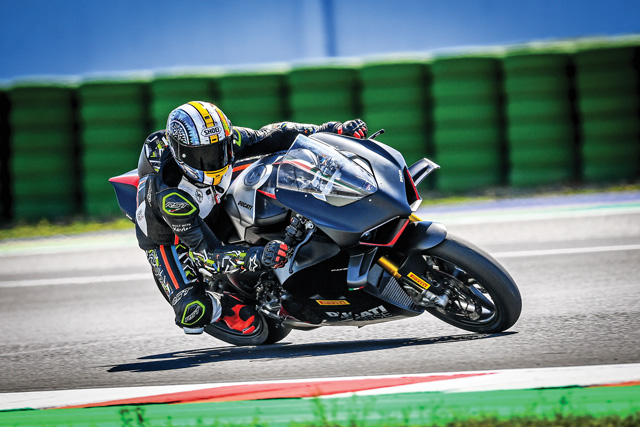
We got to ride the new SP2 alongside a standard V4 S at the Misano MotoGP racetrack.
The undamped noise of that dry clutch reverberating off the garages at Misano (and doing so just 12 hours after the WSBK team has vacated the pit-lane) is about as evocative as things get. Not many bikes can excite at tick-over, but the SP2 is certainly one of them. This is Ducati’s Italian heartland and already the bike is making me feel full factory.
Ducati have always made their SPs truly special—from 851 to V4 Panigale they are the poster bikes for each generation of Ducati superbike—and this new V4 SP2 is already making my heart beat faster than it should. Clutch in (it is slightly heavier than standard), down on the shifter (which can easily be transferred to race shift), feet back on the special Rizoma aluminium multi-adjustable foot-pegs, complete with carbon heel-guards. Clutch out and we are away, heading down the pit-lane on pre-heated Pirelli slicks.
Given the compact nature of these tests, there is no time to warm up, so it is straight into a hot lap. Immediately the Panigale gets to stretch its legs for the first time down the back straight. Even when you are not up to speed and upshifting well before the red-line at around 12,000 rpm, it is still arm-ripping quick. I have said this before: it takes a while to recalibrate to riding any Panigale V4, let alone an SP.
I have opted for the Race B mode (more below), with restricted torque in the lower gears. The power delivery is identical to the standard model’s, which I have ridden extensively in the past, and I find this mode the most suitable to how I ride.
Race A and full power is a little too aggressive, especially on a scorching 36-degree C day at Misano. Some super-sharp track specialists might disagree and want even more power and this can be achieved by fitting the Akrapovič exhaust system, but the standard power output is more than enough, even at a fast track like Misano. On most shorter domestic circuits, it will feel like flying a jet fighter around a supermarket parking lot.
Our test is conducted on a Pirelli track-day, straight after the WSBK round. The “pro” group is mainly 1,000-cc race bikes with dedicated gearing, yet the Panigale SP2 has no problems keeping up, on occasion pulling out of the slipstream and cruising past. Even when you are exhausted, you can lazily square off the corner, get back on that immense power, and breeze past slower traffic without having to push hard in the corners.
Dance on the smooth, clutch-less quick-shifter, get the revs singing, and, wow, the SP2 delivers. Now with less un-sprung and rotational mass (lighter carbon wheels), the SP2 accelerates even faster; so much so that Ducati have been forced to recalibrate the excellent electronic rider aids. Straight line speed is not a massive jump over the standard V4 S like it is when comparing the Streetfighter SP to the standard bike, but is noticeable when you ride both bikes one after the other. Some may have expected more power from the SP2 but, unless you are Alvaro Bautista, it is simply not needed.
On paper, the separation between the SP2 and the standard V4 S is not as significant as the difference between the Streetfighter SP and Streetfighter S, which, on track during a previous test, proved to be around two seconds.
We did not have the Misano track solely for our use for this test, but, in back-to-back private testing, Ducati test rider Alessandro Valia was one second faster. As both the V4 S and the SP2 use the same engine, the difference in lap-times is purely down to handling.
Let us be fair: it is hard to criticise the standard V4 S. Ducati’s recent improvements have made a significant improvement, but the changes to the SP2 put this Panigale on another level. The speed at which it turns, especially during fast direction changes, and the accuracy of its line just take this motorcycle into a class of one.
In the very fast and scary fourth and fifth-gear turns towards the end of the lap I felt I could carry more corner speed every time. The SP2 pinged from apex kerb to exit kerb and back to apex kerb with such precision that it was no more than a few millimetres different each lap, despite doing over 240 km/h.
The first section of Misano is ultra-technical and all about clipping false apexes, letting the bike drift wide, then pulling it back into the corner proper. Clean exits are vital and no more so out of Turn Six. Again, the SP2 felt easier to manage than the V4 S; I could allow it to flow and run over the kerb on the exit with confidence. The V4 S is not hard work, far from it, but after a 20-minute session of chasing race bikes in scorching Italian heat, I had more in reserve on the SP2. With less effort, I could lap at around the same speed and much of the credit must go to those lighter wheels, which save some 1.4 kg in un-sprung mass as compared to the
V4 S’ forged items.
So, too, the revised riding position. I am now sitting more in the bike and more behind the fuel-tank rather than over the fuel-cap like the old SP. The fuel-tank itself is wider and I feel better supported as well as more relaxed. It is also worth mentioning the adjustable pegs which, in the position I selected, sit ever so slightly higher than standard. The increase in clearance allowed me to carry a fraction more corner speed as it kept my toes clear of the tarmac when I was too tired to move them out of the way. The grip and feel of the pegs are also improved over standard; now you can really push through the pegs with confidence as it feels like your toes are clipped in like bicycle clips.
This is a track-only test, but I have ridden the now “old” SP on the road. The dry clutch is heavier than standard, but it is only needed when you stop or get going as the clutch-less quick-shifter changes are effortless. The electronic suspension and rider aids can be tweaked for road riding and softened accordingly, not forgetting the adjustable Rizoma pegs which can be re-positioned for a roomier riding position. Ducati call the SP2 the “Ultimate Racetrack Machine”, but some of the changes in the SP2 over standard will benefit road users. And I am sure some will be ridden on the road, simply because their owners want them to be seen. And why not!
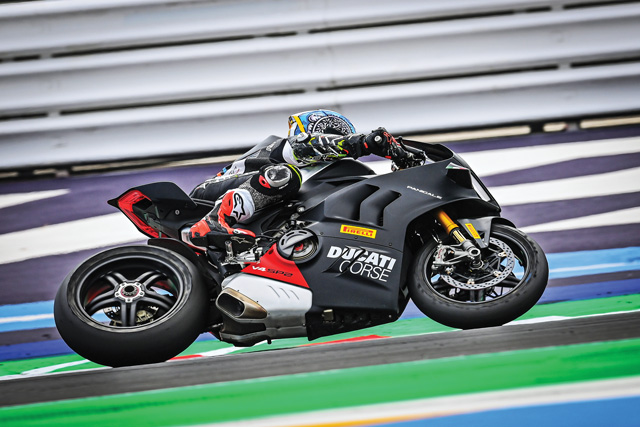
Like the older SP, the SP2 uses Brembo Stylema R four-piston radial front brake calipers and 330-millimetre discs and is supported by Bosch cornering ABS Evo. At the rear, there is a 245-mm disc with a two-pot caliper, again with cornering ABS.
I did not think there would be that much difference between the Stylema Rs and the V4 S’ Stylema items, which are incredibly strong. But there is a noticeable difference, which might in part be down to the SP’s lighter carbon wheels.
Despite riding plenty of laps on the SP2, I was still braking too early; it is hard to get your brain to understand how good the R brakes are, especially when backed up by excellent electronics. The standard V4 S stoppers are not inconsistent, but the R stoppers felt identical each lap, the pressure and stopping power required precisely the same on lap one and lap 15, despite the blistering heat and punishment. There is a lovely feel and one-to-one connection with the stoppers and the remote span-adjuster is a nice touch. I prefer the lever close into the bar and it was easy to adjust while trundling out of pit-lane. Even on track at speed, you can easily adjust the lever with your left hand whilst still accelerating on the throttle with your right.
The electronics are the same as the V4 and V4 S but recalibrated to compensate for a bike that will accelerate and decelerate quicker. The package includes Bosch Cornering ABS Evo, Ducati Traction Control (DTC) Evo 3, Ducati Wheelie Control (DWC) Evo, Ducati Slide Control (DSC), and Engine Brake Control (EBC) Evo, among the rider aids, as well as Ducati Power Launch (DPL) and Ducati Quick Shift (DPS) up-and-down Evo 2.
The SP2 also comes equipped with the GPS-based Ducati Data Analyser+ module (stored in the rear single seat) which can track your lap-times with accuracy and display each lap very clearly using the Track Evo display, derived from the one used in MotoGP. Lap-times appear at the same point each lap and, once back in the pits, you can flick through the screen to compare your best lap-times. Constantly chasing lap-times, using the rider aids to boost your performance, turns the SP2 into an arcade game, albeit a fast, expensive, and physical one.
The electronics are, as ever, phenomenal. In Race B mode you can feel the anti-wheelie holding you back slightly, but every other rider aid just goes about its business in the background. Once you learn to trust the technology, to get on the power sooner and brake even later, it is almost comical what you can get away with. Sure, there is impressive mechanical grip from the Pirelli slicks, but when you are tired or lazy and let the rider aids do all the work, it is like riding with a WSBK on your shoulder telling you what to do.
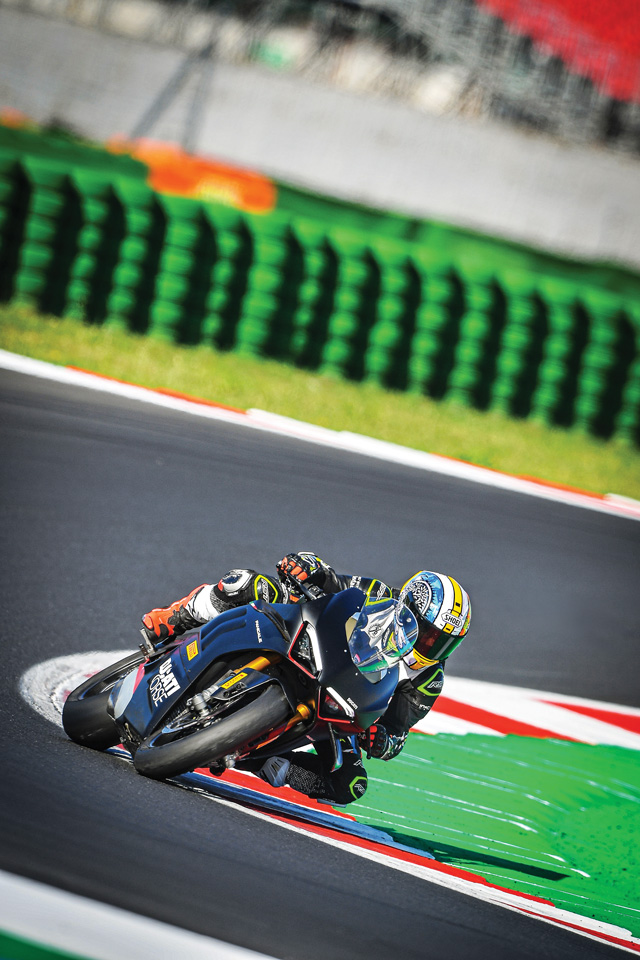
The rider aids are easy to tweak and change. Race B worked perfectly for me on a reasonably flat track like Misano where you also rarely use first gear, the wheelie control has an easy time. I was going to add a little more slide control at the end of the day as the grip of the Pirellis dropped, but I was enjoying the movement and feel of the rider aids. The electronics are simply among the best you will find in the market and impossible to fault.
The SP2 comes with a box full of goodies, which cannot be used for the road. Mirror and number-plate blanks are there to create a neat finish when you remove the number-plate and mirrors for the track. You also get that carbon open clutch cover as fitted to our test bike, which is not Euro-5 but sounds fantastic.
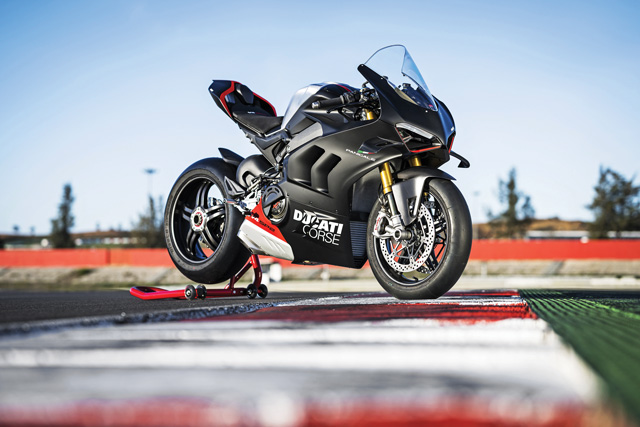
In many ways, you do not need an SP2; the standard V4 and V4 S are both excellent, produce the same power, and are already arguably leaders in the superbike class. But the SP2 is another step up, not a huge one, but certainly more track-focused than the standard bikes and able to lap quicker. The lighter carbon wheels, already present on the 2021 SP, make the largest difference: the bike is easier to ride at speed than the V4 S and turns faster and with greater accuracy. The Stylema R brakes are a small improvement, as are the multi-adjustable pegs. A remote brake span adjuster, milled levers, and the GPS module are also details that start to add up. Ducati claim this is the Ultimate Racetrack Machine and they are about right. I cannot think of a standard road bike that will lap a track quicker.
Apart from lap-times and the racetrack, however, many will simply be drawn to the jaw-dropping looks. The limited-edition SP2 is stunning in the flesh and that dry clutch sound is lovely. The now old SP Panigale sold out almost immediately and I can see the same thing happening with the hugely desirable SP2.
Also read: Indian Riders Selected For FIM MiniGP World Series Finals

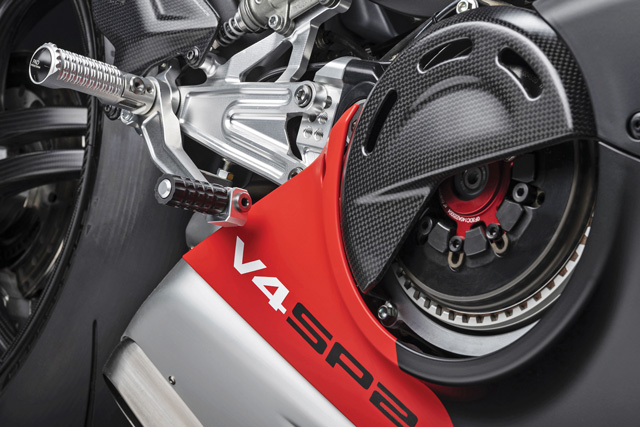
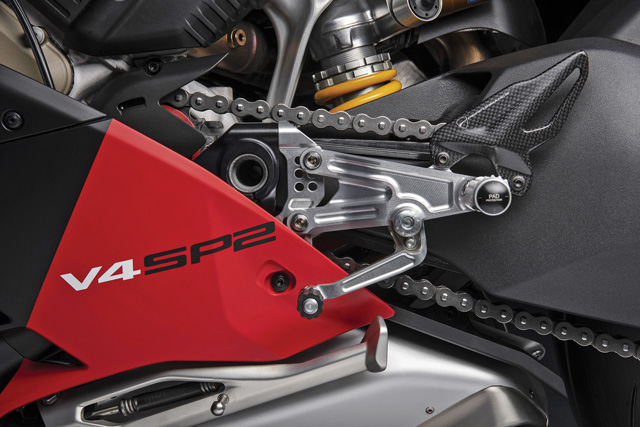
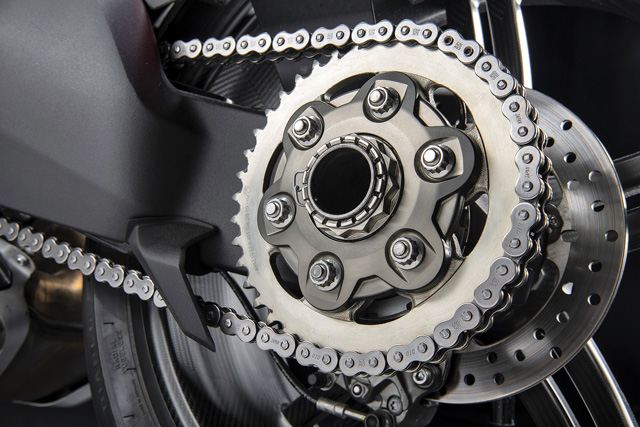
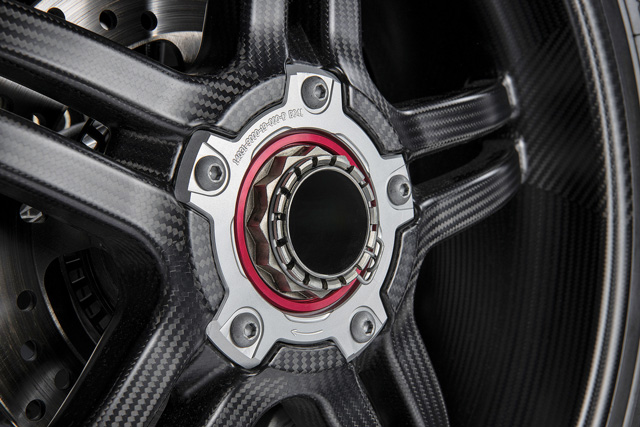
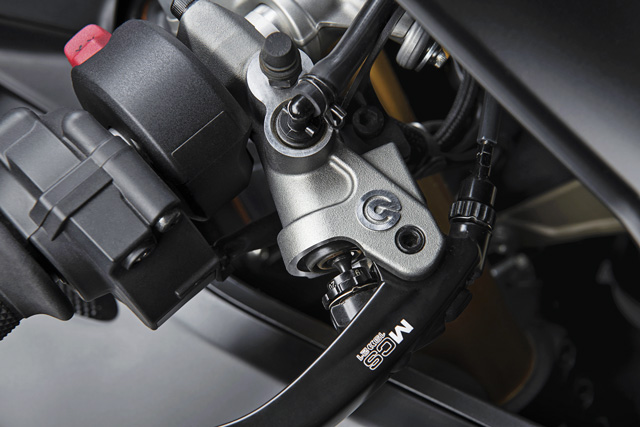
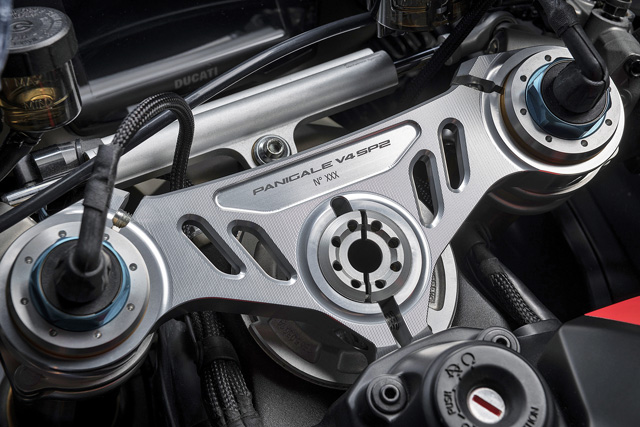
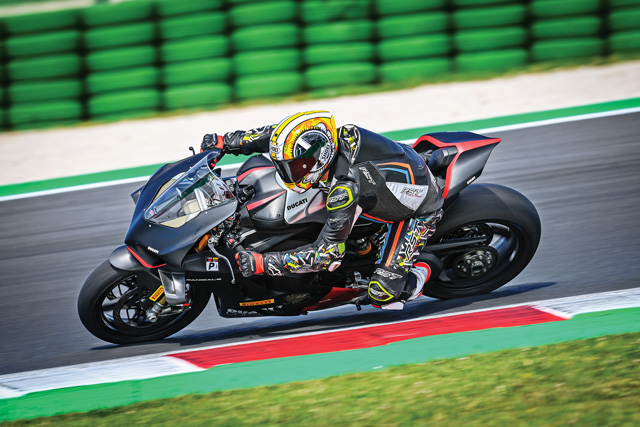

Leave a Reply